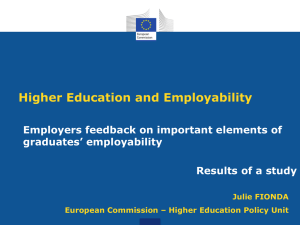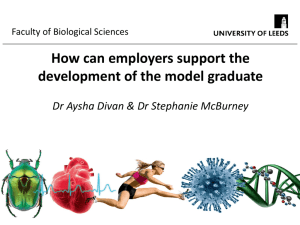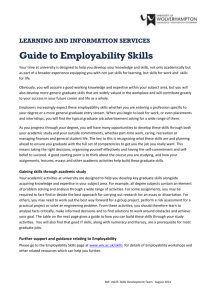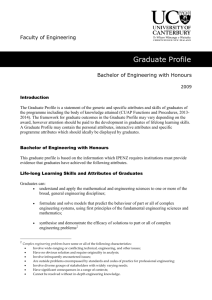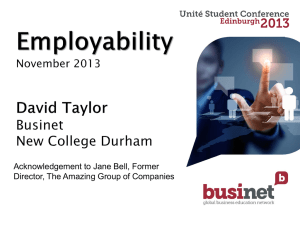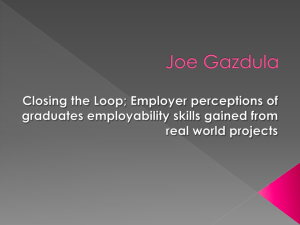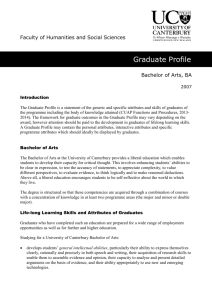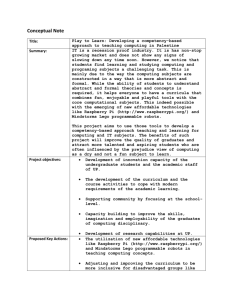Title: Exploring Direct Line Managers' Experiences and Interactions
advertisement
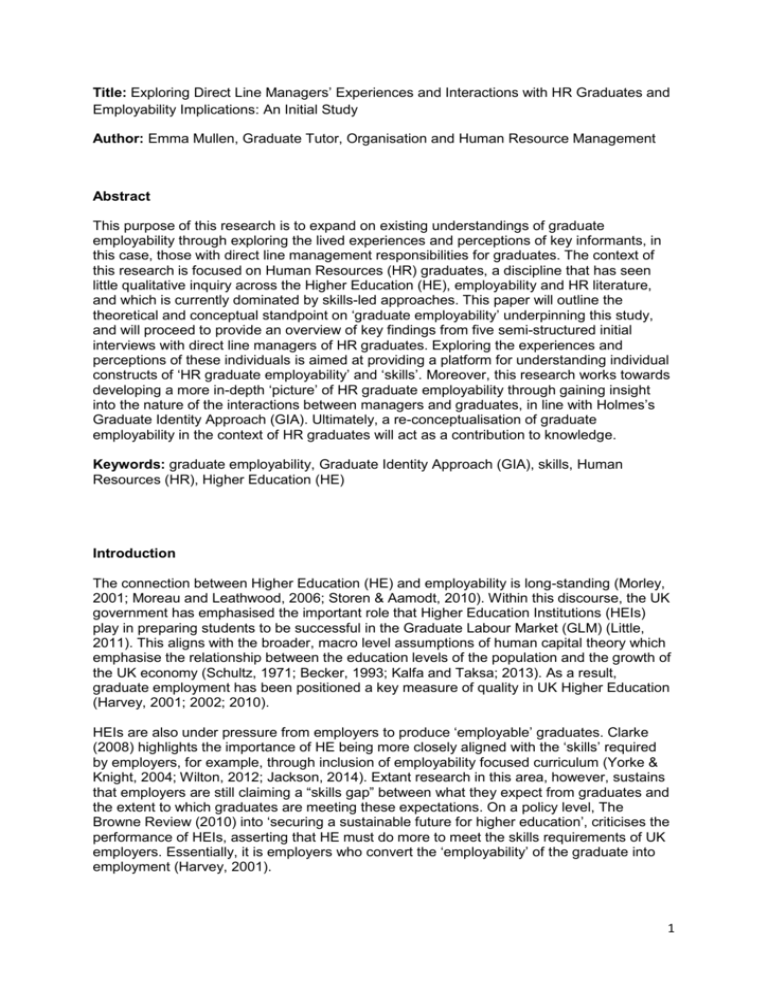
Title: Exploring Direct Line Managers’ Experiences and Interactions with HR Graduates and Employability Implications: An Initial Study Author: Emma Mullen, Graduate Tutor, Organisation and Human Resource Management Abstract This purpose of this research is to expand on existing understandings of graduate employability through exploring the lived experiences and perceptions of key informants, in this case, those with direct line management responsibilities for graduates. The context of this research is focused on Human Resources (HR) graduates, a discipline that has seen little qualitative inquiry across the Higher Education (HE), employability and HR literature, and which is currently dominated by skills-led approaches. This paper will outline the theoretical and conceptual standpoint on ‘graduate employability’ underpinning this study, and will proceed to provide an overview of key findings from five semi-structured initial interviews with direct line managers of HR graduates. Exploring the experiences and perceptions of these individuals is aimed at providing a platform for understanding individual constructs of ‘HR graduate employability’ and ‘skills’. Moreover, this research works towards developing a more in-depth ‘picture’ of HR graduate employability through gaining insight into the nature of the interactions between managers and graduates, in line with Holmes’s Graduate Identity Approach (GIA). Ultimately, a re-conceptualisation of graduate employability in the context of HR graduates will act as a contribution to knowledge. Keywords: graduate employability, Graduate Identity Approach (GIA), skills, Human Resources (HR), Higher Education (HE) Introduction The connection between Higher Education (HE) and employability is long-standing (Morley, 2001; Moreau and Leathwood, 2006; Storen & Aamodt, 2010). Within this discourse, the UK government has emphasised the important role that Higher Education Institutions (HEIs) play in preparing students to be successful in the Graduate Labour Market (GLM) (Little, 2011). This aligns with the broader, macro level assumptions of human capital theory which emphasise the relationship between the education levels of the population and the growth of the UK economy (Schultz, 1971; Becker, 1993; Kalfa and Taksa; 2013). As a result, graduate employment has been positioned a key measure of quality in UK Higher Education (Harvey, 2001; 2002; 2010). HEIs are also under pressure from employers to produce ‘employable’ graduates. Clarke (2008) highlights the importance of HE being more closely aligned with the ‘skills’ required by employers, for example, through inclusion of employability focused curriculum (Yorke & Knight, 2004; Wilton, 2012; Jackson, 2014). Extant research in this area, however, sustains that employers are still claiming a “skills gap” between what they expect from graduates and the extent to which graduates are meeting these expectations. On a policy level, The Browne Review (2010) into ‘securing a sustainable future for higher education’, criticises the performance of HEIs, asserting that HE must do more to meet the skills requirements of UK employers. Essentially, it is employers who convert the ‘employability’ of the graduate into employment (Harvey, 2001). 1 This paper begins with a background and subsequent critique of the dominant approach to ‘graduate employability’ across both academic research and UK Higher Education policy; namely the skills-led approach. Following this, alternative understandings will be considered, taking into account the role of employers as key stakeholders in line with the objectives of this study. An analysis of extant empirical work around HR graduate employability and skills will also be provided, emphasising the context for this particular study and potential contribution to knowledge. Next, the methodological approach taken for this research, including the chosen method of data analysis, is outlined. Initial findings from five initial interviews are discussed in light of the research questions, and the paper ends with a statement of implications for theory and practice. Graduate employability as ‘skills’: assumptions, criticisms, and alternatives The discourse of employability has been largely dominated by the fundamentals of human capital theory, in that the levels of education and training of the population are accredited to the growth and sustainability of the associated economy (Schultz, 1971; Becker, 1993). This is also transferable to the case of graduate employability; UK Higher Education Institutions (HEIs) are entrusted with the task of preparing graduates with the appropriate knowledge, skills and attributes to enter the GLM, gain suitable employment, and secure a desirable standard of living. An almost ‘learning is earning’ mentality is apparent (Kalfa and Taksa, 2013). Consequently, UK HEIs play a significant role in the development of human capital and the output of individuals (graduates) who are in a position to support economic and social performance. In terms of ‘skills’ and their relationship with graduate employability, The Dearing (1997) report was one of the earliest and most cited publications, based on governmental inquiry, to address the role and impact of HEIs in the UK. Specifically, it highlighted the responsibility of HEIs for students’ skills development through high quality and relevant HE provision. The report also asserted that new graduates will need to leave HE prepared with ‘transferable skills’ and ‘knowledge, skills and attributes’ in order to compete in the changing, knowledgedriven GLM. The changing demands of the labour market and influences of the ‘knowledge economy’ (Drucker, 1993) have resulted in an increased requirement for ‘skilled’ individuals from an employer’s perspective also. Subsequently, conceptualisations of graduate employability centred on the skill levels of graduates are widely documented in extant research. A flaw of the human capital approach, however, is that it essentially reduces graduate employability to over-simplified labour market outcomes. The extent to which individual decision-making and choices made in the GLM are entirely economically-driven, for instance, is actually debatable particularly in the context of graduates. Furthermore, across the HE literature it can be argued that there has been tendency, at a Governmental and HE level, to base outcomes on the number of students gaining employment after graduation, rather than the ability of the individual student to get a job (Harvey, 2001). It is likely that this is due to the effects of a mass higher education system, in that there has been a significant increase in the number of graduates leaving university seeking subsequent employment (Rae, 2007). Defined by Romenti et al (2012; 207) as “alignment with professional world requirements” or “employment rates”, it can be argued that these are often assumed, at the macro level, to be an indicator of ‘employability’ also. Reconsidering graduate employability and ‘skills’, several criticisms of skills-led approaches are presented in the literature (Little, 2011; Tomlinson, 2012; Holmes; 2013). A significant number of studies are available which report skills sets that graduates are expected to ‘possess’, collected and measured by a quantitative instrument (Nair et al, 2009; 2 Bhanugopan and Fish, 2009; Wickramasinghe and Perera, 2010). The terms ‘skills’, ‘competencies’, ‘qualities’ and ‘attributes’, however, are often used interchangeably with little discussion of how the respondents are distinguishing between these terms (characterised by Hinchliffe and Jolly (2011) as ‘skills-talk’). The results of these studies typically consist of identified skills listed in order of preference, usually from pre-defined criteria, and are not necessarily enough in isolation to advance our understanding of the dynamic nature of graduate employability. Similarly, in his recent overview of the graduate employability literature, Tomlinson (2012; 424) highlights that critics of supply-side and skills-centred approaches have challenged “the somewhat simplistic, descriptive and under-contextualised accounts of graduate ‘skills’”. Tomlinson also points out that skills taught and acquired during university do not necessarily translate into skills utilised in the workplace. James et al (2013) support this, and further highlight that there is little empirical exploration in extant studies into whether the ‘skills’ required by graduate employers are actually being translated into the workplace. An alternative approach to understanding graduate employability, which will act as a key sensitising concept for this study, is Holmes’s Graduate Identity Approach (GIA) (Holmes, 2001; 2012; 2013). For Holmes, there is a subjective element to graduate employability which interestingly challenges the assumption that skills are observable entities which can be sought, identified, possessed and ‘used’. A further supposition of the GIA emphasises that the skills agenda provides little scope for understanding the complexity of postgraduation career paths; it fails to acknowledge that the HE process is just the first stage of this path. The skills-agenda is further criticised in that it appears to conclude that the process of entering graduate level employment is simply a matter of matching skills required and skills possessed. An (arguably) more realistic notion, drawing from GIA, would recognise that constructs of ‘graduate employability’ are embedded in (employers’) interpretations of the behaviours of graduates, based on their performance once employed. In this sense, conceptualisation of graduate employability can be described as ‘processual’ in nature (Holmes, 2001; 2013). With this, Holmes also offers a critique of the taken for granted term ‘graduate’, claiming that this in itself involves a process by which an individual engages and identifies with their position as a student moving into employment. “…to be successful an individual must become a graduate, not just in the formal sense of being awarded a degree but in socially…..significant terms, whereby they act in ways that lead others to ascribe to them the identity of being a person worthy of being employed……” (Holmes, 2013; 549) Through this process, the employer will either ‘warrant’ or ‘decline’ these attempts. In this sense, the interchangeable nature of terms such as ‘skills’ and ‘competencies’ can be characterised as collection of language available to the employer, to support their warranting of these identity claims. Thus, the GIA would infer that any research which aims to extend our understanding of graduate employability needs to take these interactions and behaviours, and the social contexts in which they are situated, into account, i.e, between graduates and their ‘significant others’ (employers) (Holmes, 2013). Although Holmes, and others who have adopted his approach, appear to focus on graduates and their identity construction, this study appreciates that this interaction is a two-way process, and intends to explore the nature of these interactions from the employers’ point of view. 3 ‘Significant others’: the processual nature of employers’ perceptions of graduate employability In the discourse of graduate employability, increasing attention is being paid to employers’ perceptions (Cai 2012). This is likely to be as a result of the widely acknowledged gap between employer expectations and graduates’ ability to meet these expectations (Brown and Hesketh, 2004; Cramner, 2006; Jackson, 2012). Dominating the demand side of the GLM, employers and their expectations are also influential to the subsequent actions and priorities of HEIs, as asserted by Jackson (2009; 31): “….as the global economy evolves so will these (employability) models, and it is essential to continuously ascertain and articulate employer opinion on what makes a graduate employable, and ensure that undergraduate programs are suitably aligned”. Although human capital theory would imply a positive relationship between investments in education and the labour market, it does not take into account the influence of key stakeholder views on HE output, such as employers. Through his conceptual model around the construction of employers’ beliefs of educational output, Bailly (2008) proposes a trial and error process by which employers develop their beliefs on HE output through learning from the real performance of recruited graduates at work. In addition to being supportive of Holmes’s Graduate Identity Approach (2001; 2012; 2013), this model also accepts that such a learning process builds on initial beliefs which an employer ‘constructs’ about the graduate (for example, during the recruitment and selection process or through interacting with them at work). This could be a case of their initial beliefs being either ‘self-confirmed’ or ‘corrected’, and their experience then feeds through to their perceptions around ‘true value’ of future graduates. Essentially, it can be argued that what eventually shapes employers’ beliefs on HE output lies in a graduate’s actual performance in their workplace (Bailly, 2008; Cai, 2012). Similarly, Tomlinson (2012) suggests that the early working lives of graduates can mediate how their employers perceive and value them. HR graduate employability: where is the gap? The context for this particular study is based on graduates of the HR discipline. It has been suggested that the ability of HR graduates to add value for their new employers can be traced back to ‘proficiencies’ developed during their prior education and training (Hansen, 2002). This is supportive of earlier work by Langbert (2000) and Way (1996), which argues that the knowledge and competencies which managers and professors value for HR curriculum translate into students’ ability to perform well in subsequent HR positions. Despite this, gaps do exist between what employers hope to find and what graduates think they should be getting from their HR education (Hansen, 2002; Scarpello, 2008). This compliments the CIPD viewpoint that: “There’s a real lack of understanding of what HR is, what the value of a career in HR is and where it can take you. There’s also a lack of clarity around the skills needed to be successful in HR….” (CIPD, 2010) In the case of HR graduates, extant research can be characterised as complying with the skills-led approach. Empirical work to date largely consists of quantitative studies (primarily questionnaires/surveys and the use of rating systems and scales to assess ‘skills’) (Van Eynde & Tucker, 1997; Way, 2002; Giannantonio & Hurley, 2002; Senaratne, 2004; Heaton & Ackah, 2007). Such quantitative methodologies are a realistic choice for research which may, for example, seek to identify the differences in skills levels of employed and unemployed HR graduates (Senaratne, 2004). However, they are limited in terms of gaining rich insight into how these individuals (managers) are making sense of ‘skills’. It is also often 4 unclear in these studies whether or not these individuals have had any interactions with HR graduates. An additional limitation is that these studies rarely align; they each result in a different set of skills declared as ‘most important’. It is also interesting to note that the few studies in this area which do adopt qualitative methods still, mostly, demonstrate a focus on skills, as shown in Table 1. Consequently, a gap in understanding appears to be evident, relating to understandings of HR graduates employability and skills outside of the skills-led approach. There also appears to be very little insight into the nature of the interactions between HR graduates and their managers, and how these may contribute to perceptions of HR graduate employability. Table 1: Extant qualitative studies on HR graduates, skills and employability Source Approach Hallier and Summers (2011) UK based study into how undergraduate HRM students construct a sense of professional identity during their degree studies, involving 24 semi-structured interviews with students. Maxwell et al (2009) Mixed method approach using interviews (9) and questionnaires to explore employers’ perceptions of postgraduate HR students/graduates and their employability skills. Morse (2006) Mixed method approach of questionnaires and semi-structured interviews (7) to examine HR practitioners’ views of HRD student work placements provided by their organisation, and skill development. Hayton et al (2005) Question and answer session between a SHRM representative and 2 expert HR practitioners regarding their perspectives on market demands for HR graduates and undergraduates and implication for HR education/curriculum. The experts 5 had themselves interviewed HR academics and HR practitioners prior to this. Johnson & King (2002) 12 semi-structured interviews with HR practitioners on their views about HE courses and their ability to assist in the development of HR competencies. Kaufman (1994) Semi-structured interviews with senior HR executives regarding drivers of HR transformation and implications for the skills required of HR graduates. Thus, the scope of this study goes beyond the focus of much of the extant HR graduate employability research. It aims to provide a contribution to knowledge through advancing existing, skills-led understandings of HR graduate employability, drawing from the social processes and interactions emphasised by the GIA. This will be approached through an exploratory qualitative research design, gaining insight into the perceptions and experiences of direct line managers of HR graduates, and the following research questions will be addressed as a result: 1. What is the nature of managers’ experiences and interactions with HR graduates? 2. How is ‘HR graduate employability’ understood by those who manage HR graduates? Methodology This paper is based on analysis of an initial study, consisting of five semi-structured qualitative interviews with direct line managers of HR graduates, working in HR. An interpretivist approach was adopted in the research design and data analysis, in that it was interested in understanding how people make sense of their worlds, with human action being conceived as purposive and meaningful in relation to this sense-making (Gill and Johnson, 2010). During the interviews, participants were firstly asked to describe their background in relation to HR, before being asked to talk about their experiences of managing HR graduates, their perceptions of HR graduate employability, how they perceived the value of HR education, and their views on the role of CIPD in HR graduate employability. Where interviewees mentioned ‘skills’ in their responses, they were asked to explain how they were interpreting these. Participants were from a range of North East based organisations, including healthcare, manufacturing and retail, and in most cases the interviewee was managing graduates on a 6 specialist HR graduate scheme at the time of being interviewed. All participants were themselves graduates from UK universities, and all but one of them was a CIPD member. Ethical approval for this doctoral research was granted by the Newcastle Business School Research Ethics Committee according to requirements and guidelines set by Newcastle Business School, Northumbria University. In line with this, informed consent was received from each of the interviewees and all personal details were anonymized during the transcription (a pseudonym was assigned to each participant) and analysis stages. Interviews were digitally recorded, transcribed by the researcher, and coded in Nvivo. Template analysis was conducted to produce an initial template, representing the key themes emerging from the initial study data. An iterative process was utilised during the data analysis, consisting of the researcher going ‘back and forth’ between the data, the literature, and their own reflections on the interviews. Initial findings Challenges in managing HR graduates An unexpected finding which emerged from the initial interview data related to how the managers were characterising their experiences with HR graduates. Specifically, all of the managers referred to the challenges they faced whilst managing HR graduates at work. These challenges ranged between the five interviewees, but four dominant areas were identified; Graduates’ lack of understanding of what HR is. For example, “I think there has often been a tradition or perception that people come into the HR function to help people…there is obviously a people element to it, but it’s often just around that clarity with people, that actually…HR is here to work with the organisation, to serve the organisation….you’re not there as a staff rep…” (David). On a similar note, Sarah spoke about her frustrations around graduates not being aware of the type of HR they were going into. At the time of being interviewed, Sarah was managing HR graduates on a formal graduate scheme in a manufacturing company; “there’s not been a massive passion if you like to get into the factories….they come here and they don’t want to be here because it’s the less glamorous side of HR…” Issues around HR graduates embracing the organisation they are working in. In particular, the managers highlighted that the HR graduates they were responsible for often tended to view HR in isolation, rather than attempting to understand how their role impacted upon other departments and employees at different levels. For example, Steven emphasises that “…they need to know the business and they need to know it inside out and they need to know what people have to do…what it feels like, and what the demands and the pressures and the frustrations are….” Issues in managing new HR graduates going through the ‘transition period’. For example, Jackie spoke about the difficulties she had faced in dealing with new HR graduates entering the organisation. Specifically, she referring to the informal ways in which they would speak to senior members of staff in the workplace, and some (occasional) inappropriate behaviour. Jackie described the graduates as “institutionalised” and as still being stuck in “uni-mode”. Managing HR graduates’ expectations. 7 Moreover, it is also clear that these challenges are influential over how the managers are constructing their own meanings around ‘HR graduate employability’. During the interviews they would often refer back to the challenges they had experienced, when discussing what they considered to be ‘HR graduate employability’. For example, David referred to the challenge he personally faced in dealing with HR graduates who aren’t ready to embrace the organisation they working in. Later on in the interview when discussing HR graduate employability, the participant pointed out that embracing the different parts of the organisation aside from the HR department was key for a graduate wanting to work in HR. Managers’ sense-making around ‘HR graduate employability’ and constructs of ‘skills’ Various findings came through the five pilot interviews relating to HR graduates and their employability. Concerning the meaning of ‘HR graduate employability’ to the direct line managers, it was apparent that this was intertwined with their understanding of employability in general. Aspects such as ‘potential’ for example were discussed by the participants in relation to what they considered to be employability as well their sense-making around HR graduate employability specifically. It was also clear that each participant held their own understanding of what they considered HR graduate employability to be, which highlighted the subjectivity around the term as well as the difficulties in defining it. David claimed that it was “one of those wonderful topics or subjects or words that I can make mean whatever I want depending on the circumstance”, whereas Jackie referred to it as the ‘X Factor’. On a similar note; although this study does not intend to identify a universal, objective definition of ‘skills’, it seemed that understanding of what skills are and how these relate to HR graduates also differed across the interviewees. This was very much dependant on the type of HR the graduate was doing, the type of organisation, and the managers’ experience with the graduates. In particular, Sarah seemed to consider typical HR duties as ‘skill’. This could be traced back to the requirements of the factory environment in which their HR graduates were working: “I suppose in essence if I think of it from my perspective, it’s very much about having people who when they come in they have got the, not necessarily the skills or the experience, If you say to a graduate typically coming out of a HR degree that’s all well and good and you’ve got a degree and you understand this and you can write me a strategy paper on that. But can you tell me how to do a disciplinary hearing? Can you tell me the steps before that? How would you do an investigation? That’s skill.” Considering the extent to which ‘skills’ came into the participants’ understandings of HR graduate employability, this always appeared to be secondary to other factors such as the graduate’s commitment to a HR career, their willingness to ‘get stuck in’ with other parts of the organisation, and their understanding of ‘what HR is’ and the type of HR they were going into. In relation to this final point, a power shift towards the graduates themselves also emerged as a concern of the managers. In particular, Sarah talked about graduates’ expectations of “sexy” graduate level HR and how they were finding that they had to pay attention to managing graduates’ expectations: “I think they see the brand, particularly for a manufacturing company, they see the brand and not the reality. If you look at (organisation) for example, the brand of (organisation), it sounds quite exciting, ooo XXXX manufacturing. They don’t think about the factory, they think about what the brand is. Talk about (current organisation), wow, global company, yanno, it’s so successful I bet it’s a really glamorous environment, you know, they’ll be really high flying people, they’ll be really 8 global. And I absolutely see it in grads, they come in and they think they’re gonna jet set the world, and you’re like no we’re in a factory and we make XXXXX. Or we’re in a factory and we make XXXXX, and his life depends on every penny that he earns and he’s not from the same background as you, you know what I mean?” Conclusion These pilot studies, conducted as part of wider doctoral research, suggest that understanding behind HR graduate employability and skills is very much embedded in the contextual background of the manager and their organisation. As key stakeholders in relation to graduates and their transition into the workplace, they often relate what they consider to be ‘HR graduate employability’ back to their own experience in HE, their experience in HR as a function, and also their own interactions with CIPD. This would propose that the key to furthering our understanding of HR graduate employability is in exploring these contexts, building up a richer picture of how it translates into actual relationships between HR graduates and managers at work. The initial findings also suggest that ‘HR graduate employability’ spans outside of skill sets, and shares some characteristics with non-discipline specific employability. HR graduates awareness and understanding of CIPD seems to be lacking according to managers’ perceptions, although its relevance is placed more positively in relation to career progression in HR and as an advantage at the recruitment and selection stage. The initial template devised from these pilot studies will be taken forth into the next set of interviews, as part of this doctoral project, and built upon in relation to the emerging themes coming out of the pilot study. New themes will also be introduced where applicable. Implications for theory and practice Initial findings indicate a move towards understanding HR graduate employability as driven by managers’ own experiences and contextual backgrounds, which could also be translated across the broader graduate employability discourse. This is in addition to building upon empirical research on HR graduates and HE education which to date is vastly quantitative and restricted with regards to rich insight and understanding. There are also potential implications for HR careers literature. This research also holds practical implications for a range of stakeholders. The broader issues of employability are of particular interest to UK HEIs and graduate employers, and this research offers further understanding in the context of HR graduates which may also be transferable to HR curriculum and teaching. There will also be professional body implications, namely CIPD and links with their professional standards for early career HR professionals and accredited HR programmes. 9 References Bailly, F. (2008). The role of employers’ beliefs in the evaluation of educational output. The Journal of Socio-Economics, 37, 959-968. Barber, AE (1999) “Implications for the design of human resource management- Education, training and certification”. Human Resource Management, 38:2 pp 177-182. Becker, G.S., 1964. Human Capital: a Theoretical and Empirical Analysis with Special Reference to Education. Columbia University Press. Bhanugopan, R and Fish, A. (2009). Achieving graduate employability through consensus in the South Pacific island nation. Education+ Training. 51, 2, 108-123. Brown, P & Hesketh, A (2004). The Mismanagement of Talent: Employability and Jobs in the Knowledge Economy. Oxford University Press. Browne (2010) Securing a sustainable future for higher education, available at https://www.gov.uk/government/uploads/system/uploads/attachment_data/file/31999/101208-securing-sustainable-higher-education-browne-report.pdf (accessed 3rd July 2012) Cai, Y. (2012). Graduate employability: a conceptual framework for understanding employers’ perceptions. Higher Education, 65(4), 457-469. CIPD (2010). Think HR, Thing Again. CIPD launches new campaign to change perceptions of HR and attract new talent to profession. Retrieved on August 21 2012, from http://www.cipd.co.uk/pressoffice/press-releases/think-hr.-think-again.aspx Clarke, M. (2008). Understanding and managing employability in changing career contexts. Journal of European Industrial Training, 32(4), 258 – 284. Cramner, S (2006). Enhancing graduate employability: best intentions and mixed outcomes. Studies in Higher Education, 31:2, 169-184 Dearing, R. (1997). Higher education in the learning society. England: National Committee of Inquiry into Higher Education (NCIHE). Drucker, P. F. (1993). Post-capitalist Society. Oxford: Butterworth Heinemann. Giannantonio, CM & Hurley, AE (2002) “Executive insight into HR practices and education”. Human Resource Management Review. 12. pp 491-511. Gill, J. and Johnson, P. (2010). Research Methods for Managers. (4th ed.), London: Sage. Heaton, N & Ackah, C (2007),"Changing HR careers: implications for management education", Journal of Management Development, Vol. 26 Iss: 10 pp. 951 - 961 Hansen, WL, Berkley, RA, Craig, CJ, Denby, DR, Fitzpatrick, JA, Gheis, P, Kaplan, DM, Ruelle, DJ, Seiler, MR, Voss, LA, Yu, QS (1997) “Needed Skills for Human Resource Professionals: A Pilot Study”. Industrial Relations Research Institute. Hansen, WL (2002) “Developing new proficiencies for human resource and industrial relations professionals”. Human Resource Management Review. 12 pp 513-538. 10 Harvey, L. (2001). Defining and Measuring Employability. Quality in Higher Education, 7(2), 97-109. Harvey, L. (2002). The End of Quality. Quality in Higher Education, 8(1), 5-22. Harvey, L. & Williams, J. (2010). Fifteen Years of Quality in Higher Education, Quality in Higher Education, 16(1), 3-36. Harvey, L. & Williams, J. (2010). Fifteen Year of Quality in Higher Education (Part Two). Quality in Higher Education, 16(2), 81-113. Hayton, JC, Cohen, D, Hume, F, Kaufman, B & Taylor, J (2005) “Conversations on what the market wants from HR graduates, and how we can institutionalize innovation in teaching”. Human Resource Management Review. 15 pp 238-245. Hinchliffe, GW. & Jolly, A. (2011). Graduate identity and employability. British Educational Research Journal, 37(4), 563-584. Hoell, R.C & Henry, G.O (2003): The Relevancy of Graduate Curriculum to Human Resource Professionals' Electronic Communication, Journal of Education for Business, 78:6, 329-334 Holmes, L. (2001). Reconsidering Graduate Employability: The Graduate Identity Approach. Quality in Higher Education, 7(2), 111-119. Holmes, L. (2012). Realist and relational perspectives on graduate identity and employability: a response to Hinchliffe and Jolly. British Educational Research Journal, 39(6), 1044-1059. Holmes, L. (2013). Competing perspectives on graduate employability: possession, position or process? Studies in Higher Education, 38(4), 538-554. Jackson, D (2012). Testing a model of undergraduate competence in employability skills and its implications for stakeholders. Journal of Education and Work. 1-23. Jackson, D. (2014). Employability skill development in work integrated learning: Barriers and best practice. Studies in Higher Education, http://dx.doi.org/10.1080/03075079.2013.842221 James, S. Warhurst, C. Tholen, G. and Commander, J. (2013). What we know and what we need to know about graduate skills. Work, Employment & Society, 27(6), 952-963. Johnson, CD & King J (2002) “Are we properly training future HR/IR practitioners? A review of the curricula”. Human Resource Management Review. 12 pp 539-554. Kaufman, B. (1994). What companies are looking for in graduates of University HR programs. Labor Law Journal, 44, 503–510. Kalfa, S. and Yaksa, L. (2013). Cultural capital in business higher education: reconsidering the graduate attributes movement and the focus on employability. Studies in Higher Education. Lester, SW, Mencl, J, Maranto, C, Bourne, KA, & Keaveny, T (2010) “The Impact of Passing the Professional in Human Resources Exam on Early Career Success for Undergraduates 11 Entering the Human Resource Field” International Journal of Selection and Assessment. 18: 3 pp 282-290. Little, B. (2011) Employability for the workers-what does this mean? Education+ Training, 53(1), 57-66. Maxwell, G. Scott, B, Macfarlane, D & Williamson, E (2009). Employers as stakeholders in postgraduate employability skills development. International Journal of Management Education, 8, 2, 13-23. Moreau, M-P. & Leathwood, C. (2006) Graduates' Employment and the Discourse of Employability: a critical analysis, Journal of Education and Work, 19(4), 305-324 Morley, L. (2001). Producing New Workers: Quality, equality and employability in higher education. Quality in Higher Education, 7(2), 131-138. Morse, SM (2006),"Assessing the value: Work-based learning placements for post-graduate human resource development students?" Journal of European Industrial Training, Vol. 30 Iss: 9 pp. 735 – 755 Nair, CS, Patil, A, & Mertova, P (2009). Re-engineering graduate skills- a case study. European Journal of Engineering Education. 34:2, 131-139 Pounder, J & Al Sakka, M (2010),"Towards a model curriculum for graduate human resource management studies: A case study from the United Arab Emirates", Education, Business and Society: Contemporary Middle Eastern Issues, Vol. 3 Iss: 1 pp. 15 – 27 Rae, D. (2007). Connecting enterprise and graduate employability: Challenges to the higher education culture and curriculum? Education+ Training, 49 (8/9), 605-619. Romenti, S, Invernizzi, E. & Biraghi, S. (2012). Engaging employers to develop quality in higher education: the case of communication studies in Italy. Quality in Higher Education, 18(2), 205-220. Schultz, T. (1971). Investment in human capital. New York; Free Press. Senaratne, C. (2004). Employability of HRM Graduates in Sri Lanka. Sri Lankan Journal of Management, 9(3) Sincoff, MZ and Owen, CL (2004): ‘Content Guidelines for an Undergraduate Human Resources Curriculum: Recommendations from Human Resources Professionals’, Journal of Education for Business, 80:2, pp 80-85. Spence, M., 1973. Job market signaling. Quaterly Journal of Economics 87, 355–374. Støren, L. A. & Aamodt, P.O. (2010). The Quality of Higher Education and Employability of Graduates. Quality in Higher Education, 16(3), 297–213. Thacker, RA (2002) “Revising the HR curriculum: an academic/practitioner partnership”. Education+ Training. 44:1 pp 31-39. Tomlinson, M. (2012). Graduate employability: a review of conceptual and empirical themes. Higher Education Policy, 25(4), 407-431. 12 Van Eynde, DF & Tucker, SL (1997) “A Quality Human Resource Curriculum: Recommendations from Leading Senior HR Executives” Human Resource Management. 36: 4 pp 397-408. Way, PK (2002) “HR/IR professional’s educational needs and Master’s program curricula”. Human Resource Management Review. 12 pp 471-489. Wilton, N. (2012). The impact of work placements on skills development and career outcomes for business and management graduates. Studies in Higher Education, 37(5), 603-620. Wickramasinghe, V and Perera, L. (2010). Graduates’, university lecturers’ and employers’ perceptions towards employability skills’. Education+ Training. 52, 3, 226-244. Wooten, KC and Elden, M (2001) “Cogenerating a Competency based HRM Degree: A Model and Some Lessons from Experience”. Journal of Management Education 25: 231 Yorke, M. & Knight, P. (2004). Embedding employability in the curriculum. Learning and Employability Guides (York, LTSN-ESECT), 3. 13
